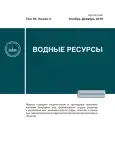River flow structure and its effect on pollutant distribution
- Authors: Chashechkin Y.D.1, Rozental O.M.2
-
Affiliations:
- Ishlinsky Institute for Problems in Mechanics, Russian Academy of Sciences
- Water Problems Institute, Russian Academy of Sciences
- Issue: Vol 46, No 6 (2019)
- Pages: 582-591
- Section: Hydrophysical processes
- URL: https://journals.eco-vector.com/0321-0596/article/view/18871
- DOI: https://doi.org/10.31857/S0321-0596466582-591
- ID: 18871
Cite item
Abstract
Observations show that the space and time heterogeneity of river water composition persists over indefinite time even when the effect of pollutant sources and sinks is minor. The driving forces of such heterogeneity have been supposed and shown to be, among other factors, the stratification of water matrix. Studying the structure of water flow and its effect on pollutant distribution in water was based on a system of fundamental equations of the mechanics of a fluid with a free surface. It has been shown that such effect is due to the fine structure of flows, vortices, waves and highgradient interfaces (ligaments), which is formed and maintained by the motion of water masses. This conclusion extends our knowledge of the hydrological characteristics of water flow, enables one to better understand the nature of the heterogeneity of natural water composition, and it is of practical significance as such heterogeneity can be taken into account in making water management decisions.
Full Text
About the authors
Yu. D. Chashechkin
Ishlinsky Institute for Problems in Mechanics, Russian Academy of Sciences
Author for correspondence.
Email: chakin@ipmnet.ru
Russian Federation, Moscow
O. M. Rozental
Water Problems Institute, Russian Academy of Sciences
Email: orosental@rambler.ru
Russian Federation, Moscow
References
- Бардаков Р.Н., Васильев А.Ю., Чашечкин Ю.Д. Расчет и измерения конических пучков трехмерных периодических внутренних волн, возбуждаемых вертикально осциллирующим поршнем // Механика жидкости и газа. 2007. № 4. С. 117-133.
- Дрюпина Е.Ю. Методические основы расчета допустимых концентраций загрязняющих веществ в сточных водах предприятий при организации городских систем водоотведения на примере г. Барнаула. Автореф. дис. ... канд. техн. наук. Барнаул, 2014. 17 с.
- Зырянов В.Н., Лапина Л.Э. Склоновые течения в морях, озерах и водохранилищах, обусловленные диффузионными эффектами // Вод. ресурсы. 2012. Т. 39. № 3. С. 292-303.
- Ландау Л.Д., Лифшиц Е.М. Гидродинамика. Теоретическая физика. Т.VI. М.: Наука, 1986. 736 с.
- Найфэ А.Х. Введение в методы возмущений. М.: Мир, 1984. 535 с.
- Прандтль Л. Гидроаэромеханика. М.: Изд-во иностран. лит., 1951. 576 с.
- Розенталь О.М., Подкин Ю.Г. Диэлектрический фрикционный эффект при переносе электролита в водной среде // ДАН. 2015. Т. 462. № 5. С. 587-589.
- Розенталь О.М., Подкин Ю.Г. Методы и средства диэлектрических измерений водных растворов электролитов // Измерит. техника. 2014. № 1. С. 67-74.
- Рона и Арв — разноцветное слияние рек https://cattur.ru/europa/switzerland/ron-i-arv.html
- Слияние рек https://www.tripadvisor.ru/ShowUserReviews-g303235-d554183-r229755948
- Чашечкин Ю.Д., Розенталь О.М. Физическая природа неоднородности состава речных вод // ДАН. 2019. Т. 485. № 5. C. 484-487.
- Anikeenko A.V., Malenkov G.G., Naberukhin Yu.I. Visualization of the collective vortex-like motions in liquid argon and water: Molecular dynamics simulation // J. Chem. Phys. 2018. V. 148. № 9. P. 094508-094518.
- Chashechkin Yu.D. Differential fluid mechanics — harmonization of analytical, numerical and laboratory models of flows // Mathematical Modeling and Optimization of Complex Structures. Springer Series “Computational Methods in Applied Sciences”. 2016. V. 40. P. 61-91. doi: 10.1007/978-3-319-23564-6-5
- Chashechkin Yu.D., Zagumennyi Ia.V. Non-equilibrium processes in non-homogeneous fluids under the action of external force // Physica Scripta. 2013. V. 155. 014010.doi: 10.1088/0031-8949/2013/T155/014010.
- Müller P. The equations of oceanic motions. Cambridge: CUP, 2006. 302 p.
- Rossi F., Vanag V.K., Epstein I.R. Pentanary cross-diffusion in water-in oil microemulsions loaded with two components of the Belousov-Zhabotinsky reaction // Chem. 2013. V. 17. № 7. P. 2138-2145.
- Sukharev Yu.I., Markov B.A. Liesegang operator. Liesegang rings as the common gross-property of oxyhydrate gel polymer systems // Изв. Коми НЦ УрО РАН.. 2002. Вып. 2(18). С. 54-66.
- Vallis G. K. Atmospheric and Oceanic Fluid Dynamics. Cambridge: CUP, 2006. 745 p.
Supplementary files















